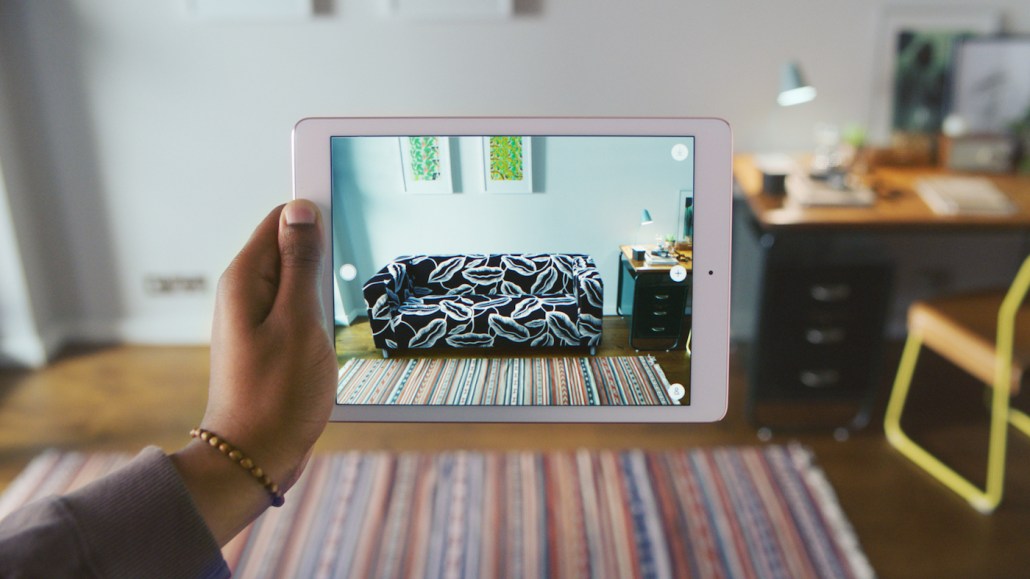
For years, Ikea has relied on shoppers visiting its stores to sell furniture, but now, it’s hoping a smartphone will drive sales.
The retailer is using augmented reality to let customers preview how furniture looks on their smartphones before they buy. Customers use Ikea Place, one of the first apps to use Apple’s ARKit tech, to place the company’s furniture wherever they envision it in their homes.
In Ikea Place, customers can view 3-D renderings from different angles of over 2,000 products before reserving the ones they want in the app, which directs to the Ikea site to complete purchases. Currently, large furniture for living rooms such as sofas, armchairs and storage units are available to preview in the app, though more products are in the pipeline.
Seeing lifelike versions of Ikea’s products in rooms lets shoppers make a “reliable buying” decision, said Michael Valdsgaard, leader of digital transformation at Inter Ikea, the holding company for Ikea.
Ikea has struggled with e-commerce sales partially because of its slow adoption of digital. Allowing people to see what a product would look like in their house without embarking on a three-hour Ikea trip could help the company with online sales, said Daisy Pledge, founder of AR startup Surreal Studios.
Valdsgaard described potential uplift in sales from AR as a “dream scenario” for Ikea, which is targeting €5 billion ($5.9 billion) in online sales by 2020, up from the €1.4 billion ($1.6 billion) it generated in 2016. The business has around 340 stores in 28 countries, with e-commerce services in 14 countries.
“Most people postpone a purchase of a new sofa because they’re not comfortable making the decision if they aren’t sure the color is going to match [the rest of the room] or it fits the style,” he said. “Now, we can give them [those answers] in their hands, while letting them have fun with home furnishing for free and with no effort.”
The app launched in the U.S. on Sept. 19, coinciding with Apple’s iOS 11 update, and is rolling out to other markets over the coming weeks. Valdsgaard declined to reveal how many times Ikea Place has been downloaded but said the reaction has been “positive,” noting that people are sharing how they’re using it online.
Early feedback on social media for Ikea Place inspired its developers to introduce a search feature for people to find specific products, which they built and launched in five days, Valdsgaard said.
“The most important thing for us is that we’re not a tech company,” he said. “In order to sell furniture, we have to understand technology and try to move in the direction it’s moving.”
Better search, more furniture and the ability to buy directly from the app could all be added to future updates. For now, the retailer is focused on driving downloads on Apple devices because the Google AR developer kits are not ready for what it wants to do. Development is being handled by Ikea’s Copenhagen, Denmark-based innovation unit Space10 and AR agency Twnkls.
Ikea Place is also working with agency 72andSunny to build a long-term proposition for the app and AR, which could play as big of a role in Ikea’s ads as its catalog has previously, like in its “Experience the power of a bookbook” campaign in 2014, a satirical take on Apple’s product promotion style that pitched Ikea’s catalog as the latest gadget. To date, ads for Ikea Place encourage people to experiment with it and have revolved around a series of short films, GIFs, a blog post and social media posts.
More in Media

How publishers are strategizing for a second Trump administration: softer news and more social media
When Donald Trump becomes president later this month, some news publishers will have updated tactics and strategies in place to cover a second Trump administration, ranging from a focus on softer news stories to more social media monitoring and engagement.

AI Briefing: Writer’s CTO on how to make AI models think more creatively
Waseem Al Sheikh, Writer’s co-founder and chief technology officer, talks about how to help LLMs think more like humans — and make fewer mistakes.

How AI could shape content and ads in 2025
Tech giants and startups alike have spent the past year building new generative AI tools for users and advertisers.








